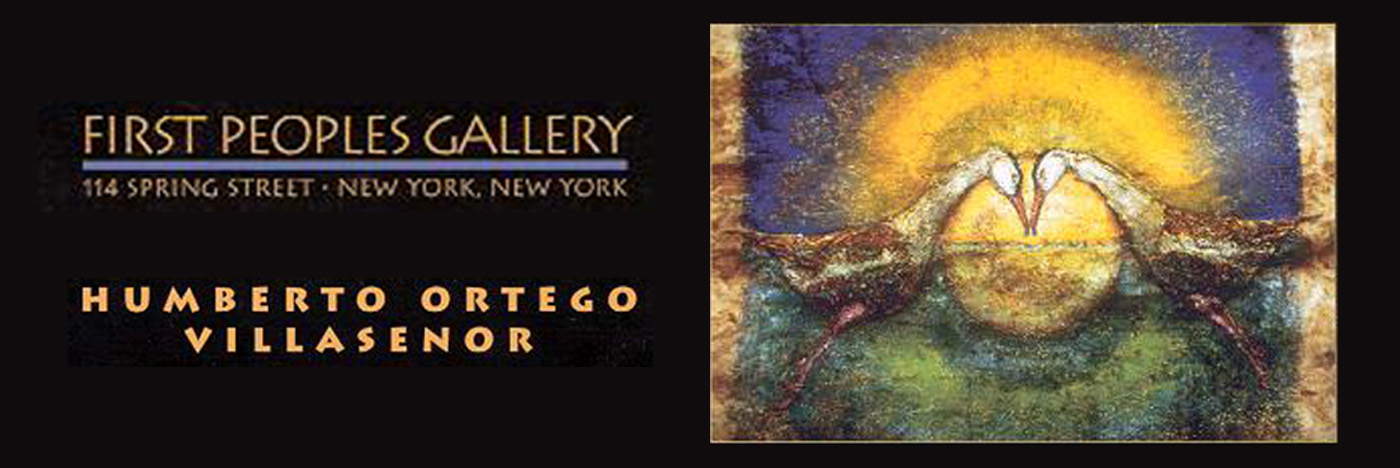H.O.Villaseñor’s Rossetta; A Brief Guide to his Art Works
As a Preamble
Humberto Ortega Villaseñor has devoted his life to trying to comprehend and decipher his own enigma as a human being, as an individual born on a specific patch of this planet and as a world citizen of his time. For years he has explored Pre-Columbian America’s paleo-spiritual structures through his art works. His entire aesthetic effort is based on valuing the past. A past that has required permanent study, reflection and re-creation of core symbols recorded on existing monuments, codices, calendars, religious and mythological texts of cultures that flourished on the continent before the European conquest. References that he sees clearly surviving in the customs, practices, artistic expressions, rituals and views of the region’s Indian communities. Villaseñor’s particular articulation is complemented by other sources and influences—mostly related to his research into similar fields and to his multi-disciplinary background—that have nourished his artistic proposal and widened the evolution of his plastic language. On the Gallery’s request, the artist has prepared a brief and humble guide (Rossetta), mainly for those spectators who, not being used to dealing with symbolic codes, the traditions of Indian communities or Pre-Columbian cultural horizons, may find it difficult to have a profound direct or total language experience with each of his works. The Rossetta has been laid out in two tables, schematically, taking into account that symbols are “…precise and crystallized means of expression, corresponding in essence to the inner life (extensive and qualitative) in opposition to the outer world (extensive and quantitative)” (Diel). “In the symbol, the particular represents the general, not as a dream, not as a shadow, but as a living and momentary revelation of the inscrutable” (Goethe). However, the author rejects the idea of limiting the spectator’s own aesthetic experience and interpretation. “Symbolic thought opens the door to immediate reality for us, but without weakening or invalidating it. Seen in this light, the Universe is no longer sealed off, nothing is isolated inside its own existence. Everything is linked by a system of correspondences and assimilations” (Elíade). This is why he has purposely avoided specifying his own sources of inner experience: sites, times, myths, deities, beliefs and philosophical schools that have allowed him to integrate his symbolic expression, although he does recognize that it is grounded in the common roots sustaining the still veiled contribution of Mesoamerican cultures to Human History. One final comment, as a subtle general guiding principle: the cyclical conception of time, the relativity of life and death, and total integration with God, Cosmos and Nature have long been the driving forces behind individual and collective inner struggles for progress, self-knowledge and transcendence among the peoples of this part of the world.
As a Basis
*The surface of each painting as such is taken as a resemblance of a five-directional sacred space in which real, geometrical or unconscious spaces can be unfolded, mixed or represented.
*Four essential elements (earth, air, fire, water) are constantly worked out inasmuch as they form part of the Pre-Columbian psycho-philosophical system.
*Backgrounds are crucial for bringing about various levels of space-time contemplation by means of chromatic resonance. Artificial perspective techniques are avoided. Spatial impact is achieved by means of the spectrum of light and color concentration, which may also be related to fourth and fifth dimensional memories.
*Imaginary x/y axes divide the surface of the canvas or bark paper in order to incorporate mathematical values
*Key cardinal points determine orientation on symmetrical and non-symmetrical planes. Their location provides mobile points of entry for linking eroticism, hedonism, physical or mystical transcendent experiences.
*The symbolic meaning, function and value of each work is organic and intended to stand by itself from the aesthetic point of view.
*The symbolic meaning, function and value of each work is relative and holistic. It may be necessary to displace an element from one section to a different one, or else it may be necessary to complete interpretations by taking diagonal or crossed readings. A figure may refer to various indicators and meanings simultaneously.
*The significance of a composition comes from the representation of weight, position, size, color and intensity of each of its elements and their systemic relationships.
